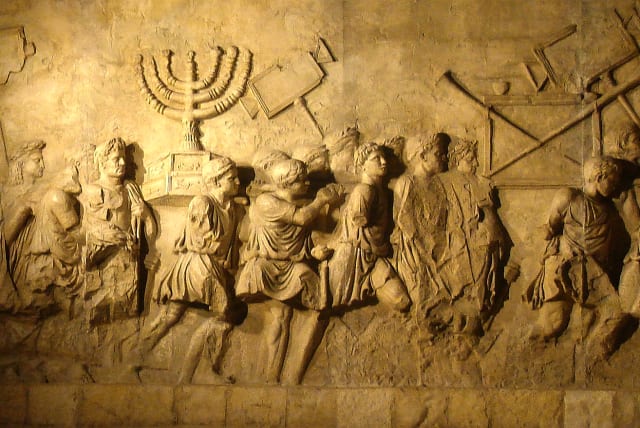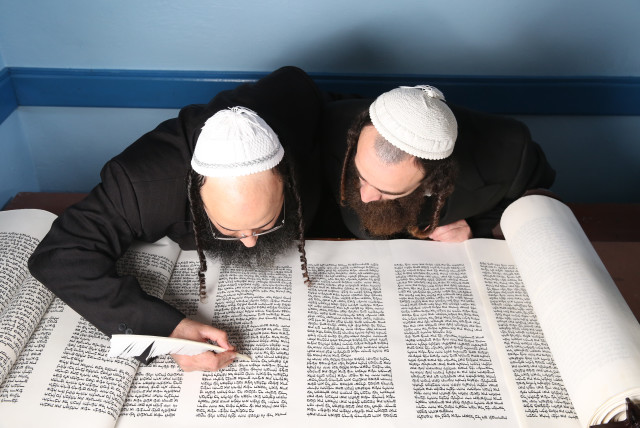Parashat Emor: ‘Ner Tamid’: Many meanings

“Tamid” therefore represents two important cadences: the persistent, non-ending; and that which reoccurs.
One of the most recognizable Jewish symbols, used for over 2,000 years, is the menorah from the ancient Temple in Jerusalem.
One of the earliest images we have of the menorah is from the reign of Antigonus II Mattathias, the last Hasmonean king of Judea, who minted coins (40-37 BCE) with images of the menorah. We also find the menorah in the Arch of Titus, built in Rome in 81 CE to celebrate the destruction of the Temple in 70 CE and the Roman victory over the First Jewish Revolt (66-70 CE).
In addition, many menorahs can be seen to this day at the Beit She’arim necropolis (a UNESCO World Heritage Site), dating from the second to fourth centuries CE. We also find menorahs used in the elaborate mosaic floors in the synagogues of Hamat Tiberias (fourth century CE), Susya (fifth-sixth century CE), Beth Alfa (sixth century CE) and Beit She’an (fifth-seventh centuries CE).
Utilized during the ensuing centuries in Jewish locations around the world, the menorah was incorporated into the official emblem of the modern State of Israel in 1949.
The menorah mentioned above is the seven-branched candelabrum. Why seven? One answer: Seven represents a whole complete unit, such as the first week of creation. The hanukkiah of the holiday of Hanukkah is a nine-branched candelabrum, with its eight candle holders commemorating that eight-day holiday, and the middle holder, the shammash, functioning as a helper candle for lighting those eight candles.
We are first introduced to the menorah in the Book of Exodus (Ex. 25:31-40) as part of the accessories of the Mishkan (Tabernacle) used by the Israelites during their 40 years in the desert. The Mishkan was their sanctuary for the worship of God. It also acted as the blueprint for Solomon’s Temple in Jerusalem.
We read in regard to the menorah in the Tabernacle: “You shall further instruct the Israelites to bring you clear oil of beaten olives for lighting, for kindling lamps regularly” (Ex. 27:20).
The Hebrew word for regularly is “tamid.” We get clarification of what “regularly” means:
“Aaron shall set them up in the Tent of Meeting outside the curtain of the Pact [to burn] from evening to morning before the Lord regularly; it is a law for all time throughout the ages. He shall set up the lamps on the pure lampstand before the Lord [to burn] regularly” (Lev. 24:3-4).
That is to say, regularly/tamid, when it comes to the menorah, means every evening. This raises a question. According to the Etz Hayim commentary (p. 503), Exodus 27:20, quoted above, is the proof text for the Ner Tamid, the Eternal Light, found above the ark in synagogues around the world. The Ner Tamid in the synagogue is lit all the time, 24/7, while the lights of the menorah in the ancient Temple (Ex. 27:20/Lev 24:2-4) were only lit at night!
How can this be reconciled?
We also learn: “The fire on the altar shall be kept burning, not to go out: every morning the priest shall feed wood to it, lay out the burnt offering on it, and turn into smoke the fat parts of the offerings of well-being. A perpetual/tamid fire shall be kept burning on the altar, not to go out” (Lev. 6:5-6).
In this instance, in reference to the fire on the altar, we see “tamid” utilized in the sense of all the time. That is to say, “tamid” has two meanings. It can be understood as perpetual, to never go out (Lev 6:5-6); and as regular, as in every night (Lev 24:2-4/Ex. 27:20).
“Tamid” therefore represents two important cadences: the persistent, non-ending; and that which reoccurs. Our breathing comprises these two elements. We breathe our entire lives, but with a signature of inhalations and exhalations.
With this insight, we can understand the Ner Tamid of the synagogue holding both of these elements of the word. The Ner Tamid can represent God, Judaism, our connection to the Jewish people as a constant, on the one hand. But on the other, it recognizes that those relationships can have their own pulse and oscillation.
AN ASTUTE observation on the complexities of the Ner Tamid is made by Hannah Sedletsky quoting Noach Dzmura:
“The original Ner Tamid was an open flame, a visible pillar of fire, casting heat and light, the engine of combustion generating noise and smoke. The Ner Tamid in our synagogues today is distant from that sensory experience. It is a symbol of a symbol.”
This confusion surrounding the Ner Tamid is also found in Midrash Tanhuma, which relates that Moses had trouble following the instructions from God how on to make the menorah:
“Moses still found difficulty with it, and when he came down, he forgot its construction. He went up and said: ‘Master of the Universe, I have forgotten [how to make it]!’ God said to him: ‘Look and make [it]’; God made its form out of fire and showed him its construction. Still, Moses found its construction difficult” (Tanhuma, Beha’alotecha 11, Buber ed.).
We find a similar idea in another midrash: “You see that Moses struggled with the design of the menorah more than with all the other vessels of the Mishkan, until the Holy One Who Is Blessed showed him with a finger” (Numbers Rabbah 15:1).
Commenting on this, Rabbi Brad Artson writes: “Why were those details so impossible to retain? What is the Torah teaching us about human beings and about being human? After all, Moses is able to remember the entire Torah (according to one tradition of how the Torah was recorded), and according to Mishna Avot (1:1) he was able to remember the entire Oral Teaching as well! How could such a skilled and gifted mind have trouble remembering the details of the menorah?
“Perhaps the Torah is telling us that even the most gifted of minds is stronger in some areas and weaker in others. Moses was a great role model for our entire people, yet he, too, was imperfect. Bezalel (as the architect of the Mishkan), who made no great contribution to Jewish law or Jewish literature, was able to make a timeless contribution that was beyond Moses’s abilities.”
The multi-meanings of the word “tamid” – constantly there or a rhythmic pattern – mirror that multifacetedness of being human. We are reminded of that layered human condition by Moses and Bezalel when it came to creating the menorah of the Mishkan and the command to kindle its “lamps regularly/ner tamid” (Ex. 27:20). The Ner Tamid of the synagogue represents the reality that the vibrancy of the universe, as well as how we experience our lives, comes in an array of perceptions and colors. ■
The writer, a Reconstructionist rabbi, is the rabbi emeritus of the Israel Congregation in Manchester Center, Vermont. He teaches at the Arava Institute for Environmental Studies at Kibbutz Ketura and at Bennington College.
Jerusalem Post Store
`; document.getElementById("linkPremium").innerHTML = cont; var divWithLink = document.getElementById("premium-link"); if (divWithLink !== null && divWithLink !== 'undefined') { divWithLink.style.border = "solid 1px #cb0f3e"; divWithLink.style.textAlign = "center"; divWithLink.style.marginBottom = "15px"; divWithLink.style.marginTop = "15px"; divWithLink.style.width = "100%"; divWithLink.style.backgroundColor = "#122952"; divWithLink.style.color = "#ffffff"; divWithLink.style.lineHeight = "1.5"; } } (function (v, i) { });

